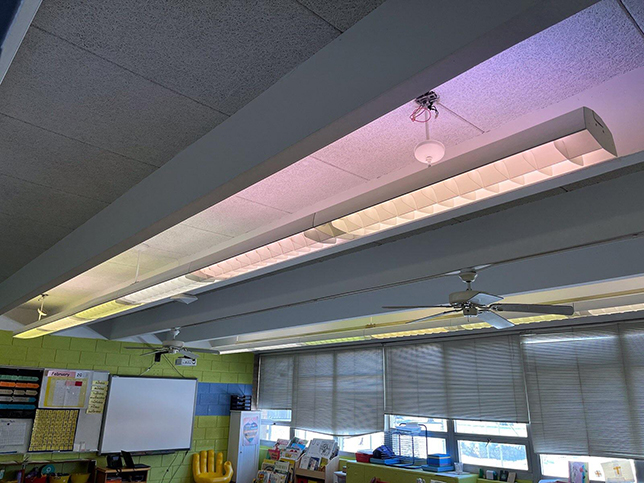Let There Be Proper Light for Learning
Michigan’s St. Augustine Catholic School Gets Top Marks for Updated Lighting System
- By Kevin Youngquist
- 11/14/23
Creating the right environment is essential to maximizing a child’s learning potential, and a critical part of that environment is the right lighting system. Studies have shown that poor lighting can interfere with reading and concentration and lead to long-term visual impairment. Excess variation in light is not only distracting but also exacerbates hyperactivity. Even lighting and consistent color temperatures, in contrast, help to create a conducive learning environment by enhancing visual acuity.
Unfortunately, the lighting system at St. Augustine Catholic School in Richmond, Mich., was failing both its students and teachers. Built in 1959, the K–8 school focuses on educating the whole child—mind, body and spirit—and integrates a Catholic identity into each subject. With approximately 200 students in total, the school offers small class sizes and a spiritual environment in which prayer is integrated into all daily activities.
This inviting environment, however, had been compromised by an outdated lighting system that had not changed much in the more than 60 years since it was originally built. The 16 classrooms and library still featured two rows of T12 linear fixtures with fluorescent lamps. Over time, the fluorescent tubes had been replaced with lamps providing different-color temperatures. In addition, the T12 linear fixtures were mounted to an exposed tectum ceiling. The end result was uneven light that created an unattractive and inefficient learning atmosphere.

Photo credit: EarthTronics LED
Time for a More Enlightening Environment
Leadership at St. Augustine School knew a change needed to be made. They wanted an energy-efficient lighting system that provided a better lumen output, consistent color temperature, and aesthetically pleasing light from fixtures made of high-quality materials. The specification team included Chris Shinska, a parishioner and electrician, as well as John Monkowski, a lighting specialist and manufacturer’s representative. After a thorough investigation and intensive review of the various specifications, the school narrowed its selection down to 2X2 and 2x4 LED troffers before considering different manufacturers and solutions that would maximize the school’s investment.
“We selected the EarthTronics LED troffers because of the sleek look of the fixtures and their low profile,” said Shinska. “Our team also liked the fact that the LED troffers offered wattage and color- selectable options to ensure proper light levels.”
Designed for easy installation in 2’x2’ grid ceilings, the dual channel troffers work seamlessly with EarthConnect Lighting Controls, providing smooth white color tuning in a range of 3500K, 4000K and 5000K with 82 CRI. The 2’x2’ fixtures can be set at 20, 25 and 30 watts at the time of installation, while the 2’x4’ LEDs can be set at 25, 30 and 35 watts. Shinska’s team chose to set the lighting at 30 and 35 watts and 5000K to maximize visual acuity in the classrooms. They also installed a drop ceiling to cover up the exposed ceiling and create a clean, more uniform look in the classrooms.
The EarthConnect control system was specifically chosen to maintain proper lighting and efficiency and provide several functions, including flexible zoning and grouping, scene control for lights or groups, and time scheduling for individual fixtures, groups, and areas.
Maximizing efficiency
“The old lighting system had 48 T12 fluorescent tubes that consumed 40 watts each for a total of 1920 watts. They also provided very uneven light delivery,” said Monkowski. “We replaced them with nine EarthTronics 2’x2’ LED troffers in each classroom. Since each one only consumed 30 watts, the total consumption per classroom was reduced to 270 watts. That is a dramatic energy savings of 1650 watts in each classroom. Plus, the LED troffers deliver more even lighting, consistent color temperature, better spacing, less hotspots and more lumens.”
Another advantage for the school is that the LED troffer fixture has a solid-state driver which delivers a long flicker-free life to further enhance the overall learning environment since flickering can cause eye strain and, sometimes, headaches. The fixtures feature 120/277V dual voltage operation and are equipped standard with a 0 – 10-volt continuous dimming driver with a dimming range capability of 10% to 100%. An optional emergency driver provides up to 90 minutes of egress lighting in the event of a power failure. This capability is required in school systems.
Parish volunteers appreciated how easy the new lighting fixtures were to install thanks, in part, to the architectural basket lens design within a slim profile fixture. As a result, the lighting project was completed over the summer and ready for the first day of school.
The 2’x2’ and 2’X4’ fixtures have a performance life rating of 100,000+ hours and come with T-bar hanger clips which are necessary to ensure a secure installation and to meet local earthquake code requirements.
“The teachers are ecstatic about the look of the new classrooms,” said Monkowski. “And the lighting system helped to make a better presentation of the school to prospective students and parents because the classrooms now look modern and well lit. Overall, the new lights create a more welcoming look and much learning environment which benefits our students and instructors.”
About the Author
Kevin Youngquist is responsible for the sales, marketing and business operations in North America for EarthTronics. He has more than 30 years of lighting experience, serving in executive roles including developing lighting specifications, as well as energy audits for hotels, long-term care and commercial buildings.